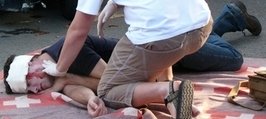How to do CPR
Confused or concerned about How to do CPR?
Do you have more questions
than answers?

If you what to know how to perform CPR go to our performing CPR page but if you are looking for answers to many common questions on how to do CPR scroll down this page!!!
Why do I need to tilt the person's head?
When a person passes out, the tongue relaxes, and it may roll back in the mouth and block their throat. Before you can start CPR on an unconscious person, you need to move their tongue out of the way.
Here's how to clear a blocked airway:
- Place the palm of your hand across the victim's forehead and push down gently.
- With the other hand, slowly lift the chin forward and slightly up using a pistol grip.
- Move the chin up until the teeth are almost together, but the mouth is still slightly open.
How do I make a pistol grip and how do I use it?
- Make a pistol grip with your thumb and index finger, roll remaining fingers into hand. It will look just like a gun the way kids use their hand to shoot in cops and robbers.
- Now place your thumb and index finger along the jaw line keeping other fingers away from the soft tissue of the neck.
- Place other hand on the forehead.
- Gently lift jaw and tilt head back.
What do I do after tilting the person's head back?
Once this is done, you have to check for signs of breathing again. Just clearing out the windpipe may sometimes be enough to allow the victim to start breathing on their own!
If the victim starts breathing, stop the CPR process and lie the person on their side if they are unconscious.
If this doesn't happen, you'll have to help them breathe, by providing rescue breathing.
How do I do rescue breathing and get oxygen into the person's lungs?
Seal the nose with thumb and index finger (hand that is on forehead). Open your mouth wide enough to make a seal over the person’s mouth. Give 2 initial rescue breaths. Check for signs of life (warmth, colour, breath) for up to 10 seconds. If there are no signs of life, commence CPR.
- ADULT - give 2 normal breaths
- CHILD - use 2 smaller breaths for a child
- BABY - seal your mouth over the baby’s mouth and nose and give 2 quick puffs
Is there enough oxygen in my breath to save a life?
The air we breathe into our lungs contains about 21% oxygen.
We use only about 1/4 of that oxygen, so we breathe out air with about 16% oxygen content. That is still enough to keep a person alive.
What about my hand position for performing CPR compressions?
- ADULT - Use two hands for the chest compressions - Put the heel of one hand on the centre of the lower half of the breastbone (sternum). With your other hand place it on top of the first hand and interlock your fingers. This enables the fingers to be held off the rib cage. This also helps prevent pressure on the person's ribs and reduces cracking a rib or two.
- CHILD – Use only one hand - Put the heel of one hand on the centre of the lower half of the breastbone/sternum
- BABY – Put 2 fingers (index and middle) in the centre of the breastbone/sternum just between the nipples
Do not "worry" about breaking a rib or bruising the heart though. If that happens it will heal afterwards.
How deep do I compress the rib cage?
- Children and infants 1/3 to 1/2 the depth of their chest.
- Adults press down about 5 cm (1 1/2 to 2 inches)
- Make sure you fully release the chest to its original position each time so the heart can fully recoil therefore refilling with blood to send around the body before you do the next compression.
How do I hold my hands to do a compression?
- Adults/children - place your hands on top of each other, keep your arms straight and lock (do not bend) your elbows so you can compress the chest fully while conserving your energy.
- Infants - Use your fingers to do chest compressions. You do not need to lock your elbows or keep your arms straight. Trying to would actually be quite awkward.
- Remember you may be doing CPR compressions for some time before help arrives so conserve your energy.
How to do CPR with 2 rescuers?
- The ratio stays at 30:2 (30 compressions then 2 ventilations) and is recommended for all ages regardless of how many rescuers are present.
- Compressions must be paused to allow for ventilations.
- Rotate rescuers between ventilations and compressions to conserve energy for both of you.
How long do I keep doing CPR for?
The rescuer should continue CPR (cardiopulmonary resuscitation) until:
- Signs of life return.
- Qualified help arrives.
- It is impossible to continue - you are too exhausted to keep going.
- An authorised person, such as a doctor, declares the person has passed away.
What course options are available to learn how to do CPR and First Aid?
To find out what options are available as well as our recommendations on organisations that run them go to our CPR and First Aid course options page.
Now you have found many of the answers on why and how to do CPR, find out how to perform CPR.
You may also be interested in the following:
- First Aid for Shock
- First Aid for Several External Bleeding
- First Aid for Internal Bleeding
- First Aid for Major Burns